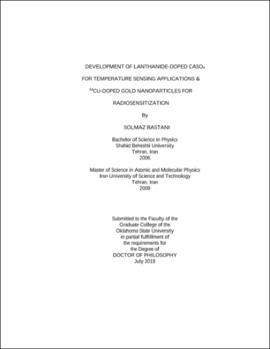| dc.contributor.advisor | McIlroy, David N. | |
| dc.contributor.author | Bastani, Solmaz | |
| dc.date.accessioned | 2021-10-21T15:42:51Z | |
| dc.date.available | 2021-10-21T15:42:51Z | |
| dc.date.issued | 2019-07 | |
| dc.identifier.uri | https://hdl.handle.net/11244/331140 | |
| dc.description.abstract | The objective of this work was to develop two different materials; lanthanide-doped CaSO4 (CSO) and Cu@Au gold nanoparticles (GNPs) for particle temperature sensing and biomedical applications, respectively. | |
| dc.description.abstract | In the first part, we synthesized CaSO4 with different lanthanides and characterized the resultant samples using x-ray diffraction (XRD), radioluminescence (RL), and thermoluminescence (TL). The TL emission was observed in most trivalent states of lanthanides including Ce3+, Pr3+, Sm3+, Gd3+, Tb3+, Dy3+, and Tm3+. In the case of Eu-doped samples, both Eu2+ and Eu3+ emissions were observed. In addition, we observed a variety of TL peaks with emission from < 100 degrees C to ~ 600 degrees C with different intensities. For temperature sensing applications, we were particularly interested in samples doped with Ce and co-doped with either Pr, Gd or Tb, due to their TL emission in the UV region with higher intensity than the single-doped samples as well as the existence of TL peaks in the high-temperature region. The results validate that the appropriate choice of dopants can produce TL peaks distributed over a wide range of temperatures with high TL intensity. For temperature sensing applications, materials with TL peaks in specific temperature regions are required, therefore, CaSO4 doped with different lanthanides are good candidates for such a purpose. Moreover, we investigated the feasibility of various methods such as initial rise method and various heating rate method to characterize the kinetics of the TL in CSO, including the determination of the order of kinetics, the activation energy (E) and the frequency factor (s). | |
| dc.description.abstract | In the second part, we developed and characterized Cu@Au GNPs using TEM, TEM/EDS, UV-vis, XPS and ICP. The binding properties of the GNPs were then evaluated in human lung cancer cells. Animal studies were implemented by doping radioactive hybrid GNPs with 64Cu (t1/2= 12.7 h). For that purpose, the 64Cu@Au GNPs were injected into animals for studying their biodistribution and pharmacokinetics. Since our hybrid Cu@Au GNPs (in which the shells are gold) have identical outer structures to that of regular GNPs, the existing GNP targeting and nano-carrier methodologies can be employed. This allows an easy transition of the technology into basic science investigation and possible clinical practice. | |
| dc.format | application/pdf | |
| dc.language | en_US | |
| dc.rights | Copyright is held by the author who has granted the Oklahoma State University Library the non-exclusive right to share this material in its institutional repository. Contact Digital Library Services at lib-dls@okstate.edu or 405-744-9161 for the permission policy on the use, reproduction or distribution of this material. | |
| dc.title | Development of lanthanide-doped CaSO4 for temperature sensing applications and 64Cu-doped gold nanoparticles for radiosensitization | |
| dc.contributor.committeeMember | McKeever, Stephen | |
| dc.contributor.committeeMember | Gali, Hariprasad | |
| dc.contributor.committeeMember | Conway, Tyrrell | |
| osu.filename | Bastani_okstate_0664D_16426.pdf | |
| osu.accesstype | Open Access | |
| dc.type.genre | Dissertation | |
| dc.type.material | Text | |
| dc.subject.keywords | 64cu | |
| dc.subject.keywords | calcium sulfate | |
| dc.subject.keywords | gold nanoparticles | |
| dc.subject.keywords | pharmacokinetics | |
| dc.subject.keywords | temperature sensing | |
| dc.subject.keywords | thermoluminescence | |
| thesis.degree.discipline | Physics | |
| thesis.degree.grantor | Oklahoma State University | |
